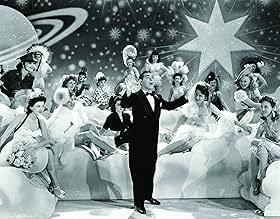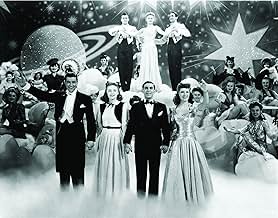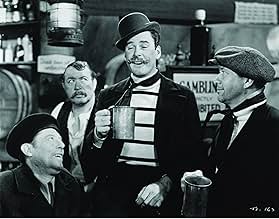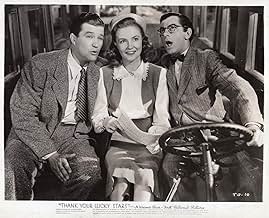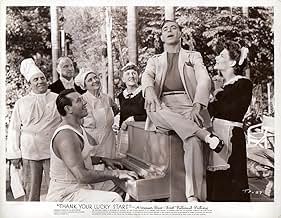NOTE IMDb
6,7/10
2,2 k
MA NOTE
Ajouter une intrigue dans votre langueTwo producers are putting together a wartime charity show with an all-star cast, but the egotism of radio personality Eddie Cantor disrupts their plans.Two producers are putting together a wartime charity show with an all-star cast, but the egotism of radio personality Eddie Cantor disrupts their plans.Two producers are putting together a wartime charity show with an all-star cast, but the egotism of radio personality Eddie Cantor disrupts their plans.
- Réalisation
- Scénario
- Casting principal
- Nommé pour 1 Oscar
- 1 victoire et 1 nomination au total
S.Z. Sakall
- Dr. Schlenna
- (as S.K. Sakall)
Avis à la une
Before I comment on the film, I just have to say that Dinah Shore's songs in this film are as bad as the "bad" song Joan Leslie is supposed to have written. I think she called it "Moondust" or some such thing.
While the stars occasionally shine in this Warner Bros. musical tribute, it's Eddie Cantor who deserves the most praise for providing most of the laughs. Cantor's dual role as a taxicab driver and an Eddie Cantor lookalike gives him some hilarious moments as he helps Joan Leslie and Dennis Morgan crash the studio gates with his Cantor impersonation. The Warner stock company (including S.Z. Sakall, Edward Everett Horton and many others) is on hand in supporting roles while the stars are given some amusing skits to appear in.
Errol Flynn is amusing in a cockney song-and-dance routine in a pub, Bette Davis talk-sings her way through 'They're Either Too Young Or Too Old', Ida Lupino and Olivia de Havilland do a jive number, mugging outrageously while chewing gum and mouthing words to a song called 'The Dreamer', Dinah Shore warbles an undistinguished song or two, Alexis Smith dances with style and grace, Ann Sheridan does a rather tiresome song number and Jack Carson and Alan Hale struggle through a less than witty routine that defeats both of them.
Humphrey Bogart, John Garfield (obviously tone deaf when he renders "Blues in the Night") and Sydney Greenstreet make fleeting appearances. Hattie McDaniel appears in an unusual novelty number. As one reviewer pointed out, "It's more like amateur night at the studio." But thanks to Cantor, the perky charm of Joan Leslie despite some awful songs and the appealing Dennis Morgan, it all comes together--silly, but lots of fun. Must have been a big hit with the servicemen during the war years, but just don't expect Grade A entertainment.
While the stars occasionally shine in this Warner Bros. musical tribute, it's Eddie Cantor who deserves the most praise for providing most of the laughs. Cantor's dual role as a taxicab driver and an Eddie Cantor lookalike gives him some hilarious moments as he helps Joan Leslie and Dennis Morgan crash the studio gates with his Cantor impersonation. The Warner stock company (including S.Z. Sakall, Edward Everett Horton and many others) is on hand in supporting roles while the stars are given some amusing skits to appear in.
Errol Flynn is amusing in a cockney song-and-dance routine in a pub, Bette Davis talk-sings her way through 'They're Either Too Young Or Too Old', Ida Lupino and Olivia de Havilland do a jive number, mugging outrageously while chewing gum and mouthing words to a song called 'The Dreamer', Dinah Shore warbles an undistinguished song or two, Alexis Smith dances with style and grace, Ann Sheridan does a rather tiresome song number and Jack Carson and Alan Hale struggle through a less than witty routine that defeats both of them.
Humphrey Bogart, John Garfield (obviously tone deaf when he renders "Blues in the Night") and Sydney Greenstreet make fleeting appearances. Hattie McDaniel appears in an unusual novelty number. As one reviewer pointed out, "It's more like amateur night at the studio." But thanks to Cantor, the perky charm of Joan Leslie despite some awful songs and the appealing Dennis Morgan, it all comes together--silly, but lots of fun. Must have been a big hit with the servicemen during the war years, but just don't expect Grade A entertainment.
See all of your favorite 1940s Warner Bros. stars as you've never seen them before!
This star-studded WWII morale-booster is not unlike similar star-studded WWII morale-boosters put out by other studios, featuring the big names in brief cameos sprinkled throughout a thin "let's put on a benefit" plot. Here the WB stars perform little vaudeville sketches, singing and dancing, as part of a charity show. And we're talking some big names here: Bette Davis, Errol Flynn, Olivia de Havilland, John Garfield, Ida Lupino, Ann Sheridan, Jack Carson, etc.
The real star, however, is Eddie Cantor. Much of the movie is about how annoying and overbearing Cantor is, with Cantor in a dual role as both a parody of himself and his resentful look-alike. In an exhibit of good-humored self-deprecation, Cantor allows his name to be dragged through the mud by critics of his corny jokes and swollen ego (his alternate character among them). As one character or the other Cantor moves the screwy plot along.
This movie is simply a star-studded, feel-good musical. And it is a lot of fun. The stars who really shine in this are John Garfield, Bette Davis, and Cantor. Dinah Shore is featured prominently in her first screen appearance and we even get to see Spike Jones and His City Slickers in action. Errol Flynn has a nice number and Alexis Smith shows off her dancing background. S.Z. Sakall is hilarious as always and the young romantic couple (Joan Leslie and Dennis Morgan) make sure to plug recent WB successes. (Leslie lets go with impressions of Lupino and James Cagney.)
It's interesting, in the scene where Olivia de Havilland and Ida Lupino dance on either side of George Tobias (in a slightly awkward jive routine), to note the contrast in the actresses' performances. Both de Havilland and Lupino are in the frame, basically playing clones of each other. But it seems like de Havilland just put so much more into her performance, particularly with her facial expressions.
It's a treat to see all of these stars in one movie and it's a treat to see them do something fun and different. The songs won't always blow you away, but they're pleasant enough. The finale is a medley of all the songs we've heard, with the welcome return of the stars we've seen. It's a fitting cap to the viewer's journey, and should leave everyone in a good mood. I think I liked the music more after hearing it all reprised in the finale.
Top-billed Humphrey Bogart has about a minute of screen time and, though he leaves an impression, he doesn't do any singing or dancing.
This star-studded WWII morale-booster is not unlike similar star-studded WWII morale-boosters put out by other studios, featuring the big names in brief cameos sprinkled throughout a thin "let's put on a benefit" plot. Here the WB stars perform little vaudeville sketches, singing and dancing, as part of a charity show. And we're talking some big names here: Bette Davis, Errol Flynn, Olivia de Havilland, John Garfield, Ida Lupino, Ann Sheridan, Jack Carson, etc.
The real star, however, is Eddie Cantor. Much of the movie is about how annoying and overbearing Cantor is, with Cantor in a dual role as both a parody of himself and his resentful look-alike. In an exhibit of good-humored self-deprecation, Cantor allows his name to be dragged through the mud by critics of his corny jokes and swollen ego (his alternate character among them). As one character or the other Cantor moves the screwy plot along.
This movie is simply a star-studded, feel-good musical. And it is a lot of fun. The stars who really shine in this are John Garfield, Bette Davis, and Cantor. Dinah Shore is featured prominently in her first screen appearance and we even get to see Spike Jones and His City Slickers in action. Errol Flynn has a nice number and Alexis Smith shows off her dancing background. S.Z. Sakall is hilarious as always and the young romantic couple (Joan Leslie and Dennis Morgan) make sure to plug recent WB successes. (Leslie lets go with impressions of Lupino and James Cagney.)
It's interesting, in the scene where Olivia de Havilland and Ida Lupino dance on either side of George Tobias (in a slightly awkward jive routine), to note the contrast in the actresses' performances. Both de Havilland and Lupino are in the frame, basically playing clones of each other. But it seems like de Havilland just put so much more into her performance, particularly with her facial expressions.
It's a treat to see all of these stars in one movie and it's a treat to see them do something fun and different. The songs won't always blow you away, but they're pleasant enough. The finale is a medley of all the songs we've heard, with the welcome return of the stars we've seen. It's a fitting cap to the viewer's journey, and should leave everyone in a good mood. I think I liked the music more after hearing it all reprised in the finale.
Top-billed Humphrey Bogart has about a minute of screen time and, though he leaves an impression, he doesn't do any singing or dancing.
I am the world's biggest sucker for All Star Films and the genre was never better than during the World War II era, when all the major studios made at least one of them as a morale booster. They all involve getting the stars at the various studios to put on a show for the troops which they do, but with a few problems.
Producers of this show Edward Everett Horton and S.Z. Sakall would like to get Dinah Shore for their show. But she's under contract to Eddie Cantor. Today's moviegoers would not be aware of the fact that at the time Thank Your Lucky Stars was filmed, Dinah Shore was a regular on Eddie Cantor's radio show. And in fact he did have her under contract.
Cantor was also a man known to have a big ego and known for interfering with every aspect of production in film, stage, and radio. His character though in film was the meek little schnook who somehow triumphs over adversity.
Cantor may have had the ego, but he was also a big enough man to allow this public lampooning of his image. He plays two roles in this, as himself and as tour bus driver Joe Simpson who can't get a break because he looks like Eddie Cantor. In between all the musical numbers the plot is simply to have Cantor kidnapped and Joe Simpson to take his place so that Dennis Morgan can get some exposure. Of course there's a young love subplot involving hopefuls Morgan and Joan Leslie, but it doesn't interfere with a plot that's taken from The Man In the Iron Mask.
Arthur Schwartz and Frank Loesser wrote a nice score for this film and the big hit was a number talk/sung by Bette Davis, They're Either Too Young Or Too Old. This number was later done in the Jane Froman bio-film With A Song in My Heart with Susan Hayward lipsynching Jane Froman's record.
I also liked another number where a major Warner Brothers Star lampooned his image and had a jolly good time, singing That's What You Jolly Well Get. Errol Flynn was reported to have enjoyed himself immensely doing that very funny song.
Thank Your Lucky Stars is one of the most pleasant nostalgia trips to a bygone era of the studio system. You couldn't afford to pay all the stars in this film today if they were all free lance independent contractors today. It's why films like this can't be made again.
Producers of this show Edward Everett Horton and S.Z. Sakall would like to get Dinah Shore for their show. But she's under contract to Eddie Cantor. Today's moviegoers would not be aware of the fact that at the time Thank Your Lucky Stars was filmed, Dinah Shore was a regular on Eddie Cantor's radio show. And in fact he did have her under contract.
Cantor was also a man known to have a big ego and known for interfering with every aspect of production in film, stage, and radio. His character though in film was the meek little schnook who somehow triumphs over adversity.
Cantor may have had the ego, but he was also a big enough man to allow this public lampooning of his image. He plays two roles in this, as himself and as tour bus driver Joe Simpson who can't get a break because he looks like Eddie Cantor. In between all the musical numbers the plot is simply to have Cantor kidnapped and Joe Simpson to take his place so that Dennis Morgan can get some exposure. Of course there's a young love subplot involving hopefuls Morgan and Joan Leslie, but it doesn't interfere with a plot that's taken from The Man In the Iron Mask.
Arthur Schwartz and Frank Loesser wrote a nice score for this film and the big hit was a number talk/sung by Bette Davis, They're Either Too Young Or Too Old. This number was later done in the Jane Froman bio-film With A Song in My Heart with Susan Hayward lipsynching Jane Froman's record.
I also liked another number where a major Warner Brothers Star lampooned his image and had a jolly good time, singing That's What You Jolly Well Get. Errol Flynn was reported to have enjoyed himself immensely doing that very funny song.
Thank Your Lucky Stars is one of the most pleasant nostalgia trips to a bygone era of the studio system. You couldn't afford to pay all the stars in this film today if they were all free lance independent contractors today. It's why films like this can't be made again.
Thin plot but nice songs and an assortment of WB stars make for an imperfect but enjoyable musical comedy. Acquired taste Eddie Cantor plays two roles so grit your teeth for that. He's very corny and vaudevillian. I'm not typically a fan of his but this is one of his more tolerable movies. In addition to regular singers Dinah Shore, Dennis Morgan, and Ann Sheridan, there are rare musical numbers by Bette Davis, Errol Flynn, John Garfield, and Ida Lupino. Garfield can't sing to save his life but the others are good. Aside from these, my favorite number in the movie is probably the all-black "Ice Cold Katie" number with Hattie McDaniel. Also an amusing non-musical cameo from Humphrey Bogart. Despite its flaws and overlength, it's hard to dislike. An enjoyable bit of fluff that will especially please fans of classic movie stars.
Cantor was one of the biggest stars of his time. And this WW-II extravaganza showcases his comedy talents playing himself and a look-alike cab driver. Dennis Morgan and Joan Leslie are the lovers, Dinah Shore gets a big buildup but her songs are drippy and awful. Edward Everett Horton and S.Z. Sakall are fun as the guys running the Cavalcade that Cantor forces himself into. Humphrey Bogart does a limp cameo, and big Warners stars appear in a series of funny stage numbers. Bette Davis, Ann Sheridan, and Errol Flynn sing; Olivia de Havilland and Ida Lupino do a jive number; Hattie McDaniel sings in a Harlem number; Jack Carson and Alan Hale do an old-time Vaudeville number; Alexis Smith dances; Spike Jones does a novelty number; John Garfield sings on Cantor's radio show, etc. But aside from seeing these big stars, it's Eddie Cantor who makes this worthwhile. A HUGE stage, movie, and radio star, Cantor is wonderful lampooning himself (a la Bob Hope) and playing the nebbish cabbie (a la Woody Allen). While many of his Broadway contemporaries never quite made it in films (Sophie Tucker, Fannie Brice, George Jessell, Al Jolson, Marilyn Miller), Cantor's starring film career lasted almost 20 years, dating from the smash hit Whoopie! in 1930; his radio career lasted 30 years. Cantor is sadly forgotten now, but he was such a big star he won a special Oscar for his film work and his humanitarian efforts.
Le saviez-vous
- AnecdotesWhen Conrad Wiedell takes Bette Davis and does the jitterbug, she felt he was holding back in rehearsals and told him to treat her like an experienced dance partner. When the cameras rolled, Wiedell--a national jitterbug champion hired specifically for this dance--pulled out all the stops and swung her around and she fell on her knee. As she finishes her song, she is seen limping out of the nightclub set and leaning against a post, rubbing her knee. This was a real injury, but she finished the song despite the pain. When director David Butler asked Davis to "try it once more," she replied, "No! No! I said one take, and that was it." She then turned to the press who had shown up to watch her number, telling them "Show's over, gentlemen. Now get the hell out."
- GaffesIn one of the scenes, Eddie Cantor dressed as an American Indian, is being chased by other men dressed as American Indians, the film negative has been flipped; the signs on store windows are backward/mirror images.
- Citations
Humphrey Bogart: [after an effort at being tough has no effect whatsoever on S.K. Sakall] Hey, I must be losing my touch! I hope my movie fans don't hear about this!
- Crédits fousAt the end, the words "THE END" are sewn into the curtains.
- ConnexionsFeatured in Arena: Bette Davis: A Basically Benevolent Volcano (1983)
- Bandes originalesThank Your Lucky Stars
(1943) (uncredited)
Music by Arthur Schwartz
Lyrics by Frank Loesser
Performed by Dinah Shore on a radio show
Reprised by a chorus at the end
Meilleurs choix
Connectez-vous pour évaluer et suivre la liste de favoris afin de recevoir des recommandations personnalisées
- How long is Thank Your Lucky Stars?Alimenté par Alexa
- Chicago Opening Happened When?
Détails
- Date de sortie
- Pays d’origine
- Langue
- Aussi connu sous le nom de
- Thank Your Lucky Stars
- Lieux de tournage
- Beverly Hills, Californie, États-Unis(tour of stars' homes)
- Société de production
- Voir plus de crédits d'entreprise sur IMDbPro
Box-office
- Budget
- 1 568 000 $US (estimé)
- Durée2 heures 7 minutes
- Couleur
- Rapport de forme
- 1.37 : 1
Contribuer à cette page
Suggérer une modification ou ajouter du contenu manquant

Lacune principale
By what name was Remerciez votre bonne étoile (1943) officially released in India in English?
Répondre
